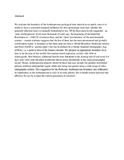| dc.contributor.author | Zalasiewicz, J | |
| dc.contributor.author | Waters, C N | |
| dc.contributor.author | Williams, M | |
| dc.contributor.author | Barnosky, A D | |
| dc.contributor.author | Cearreta, A | |
| dc.contributor.author | Crutzen, P | |
| dc.contributor.author | Oreskes, N | |
| dc.contributor.author | Odada, E O | |
| dc.date.accessioned | 2015-03-13T11:48:10Z | |
| dc.date.available | 2015-03-13T11:48:10Z | |
| dc.date.issued | 2015 | |
| dc.identifier.citation | Zalasiewicz, J., Waters, C. N., Williams, M., Barnosky, A. D., Cearreta, A., Crutzen, P., ... & Oreskes, N. (2015). When did the Anthropocene begin? A mid-twentieth century boundary level is stratigraphically optimal. Quaternary International. | en_US |
| dc.identifier.uri | http://hdl.handle.net/11295/81220 | |
| dc.description.abstract | We evaluate the boundary of the Anthropocene geological time interval as an epoch, since it is useful to have a consistent temporal definition for this increasingly used unit, whether the presently informal term is eventually formalized or not. Of the three main levels suggested – an ‘early Anthropocene’ level some thousands of years ago; the beginning of the Industrial Revolution at ∼1800 CE (Common Era); and the ‘Great Acceleration’ of the mid-twentieth century – current evidence suggests that the last of these has the most pronounced and globally synchronous signal. A boundary at this time need not have a Global Boundary Stratotype Section and Point (GSSP or ‘golden spike’) but can be defined by a Global Standard Stratigraphic Age (GSSA), i.e. a point in time of the human calendar. We propose an appropriate boundary level here to be the time of the world's first nuclear bomb explosion, on July 16th 1945 at Alamogordo, New Mexico; additional bombs were detonated at the average rate of one every 9.6 days until 1988 with attendant worldwide fallout easily identifiable in the chemostratigraphic record. Hence, Anthropocene deposits would be those that may include the globally distributed primary artificial radionuclide signal, while also being recognized using a wide range of other stratigraphic criteria. This suggestion for the Holocene–Anthropocene boundary may ultimately be superseded, as the Anthropocene is only in its early phases, but it should remain practical and effective for use by at least the current generation of scientists. | en_US |
| dc.language.iso | en | en_US |
| dc.publisher | University of Nairobi | en_US |
| dc.title | When did the Anthropocene begin? A mid-twentieth century boundary level is stratigraphically optimal | en_US |
| dc.type.material | en | en_US |

